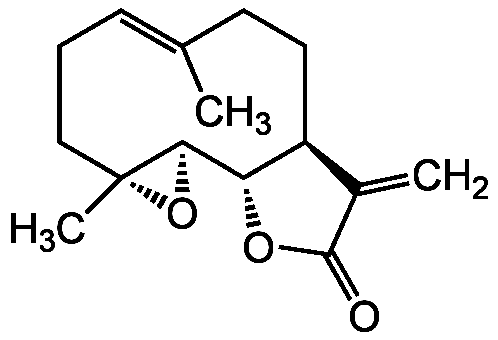Parthenolide
Product Code:
AG-CN2-0455
AG-CN2-0455
Regulatory Status:
RUO
RUO
Shipping:
Ambient
Ambient
Storage:
+4°C
+4°C
No additional charges, what you see is what you pay! *
| Code | Size | Price |
|---|
| AG-CN2-0455-M010 | 10 mg | £35.00 |
Quantity:
| AG-CN2-0455-M050 | 50 mg | £70.00 |
Quantity:
| AG-CN2-0455-M250 | 250 mg | £170.00 |
Quantity:
Prices exclude any Taxes / VAT
Stay in control of your spending. These prices have no additional charges, not even shipping!
* Rare exceptions are clearly labelled (only 0.14% of items!).
* Rare exceptions are clearly labelled (only 0.14% of items!).
Multibuy discounts available! Contact us to find what you can save.
This product comes from: Switzerland.
Typical lead time: 7-10 working days.
Contact us for more accurate information.
Typical lead time: 7-10 working days.
Contact us for more accurate information.
- Further Information
- Documents
- References
- Related Products
- Show All
Further Information
Appearance:
White to light green solid.
CAS:
20554-84-1
EClass:
32160000
Form (Short):
liquid
GHS Symbol:
GHS07
Handling Advice:
Protect from light.
Hazards:
H302
InChi:
InChI=1S/C15H20O3/c1-9-5-4-8-15(3)13(18-15)12-11(7-6-9)10(2)14(16)17-12/h5,11-13H,2,4,6-8H2,1,3H3/b9-5+/t11-,12-,13+,15+/m0/s1
InChiKey:
KTEXNACQROZXEV-PVLRGYAZSA-N
Long Description:
Chemical. CAS: 20554-84-1. Formula: C15H20O3. MW: 248.3. Isolated from Magnolia grandiflora. Anticancer and antiangiogenic compound. Induces apoptosis, cell cycle arrest and autophagy in various cancer cell lines. At low concentrations acts as antioxidant reducing oxidative stress generated through the TCR signaling pathway. At high concentration induces O2- and causes oxidative-stress-mediated apoptosis. Potent anti-inflammatory and anti-atherosclerotic agent. NF-kappaB inhibitor by directly targeting IkappaB kinase. Inhibits STAT-mediated anti-apoptotic gene transcription. NLRP3 inflammasome inhibitor. Inhibits ATPase activity of NLRP3 and protease activity of caspase 1. Directly binds the pattern recognition receptor NOD2. Specifically inhibits HDAC1 without affecting other class I/II HDACs. DNA methyltransferase 1 (DNMT1) inhibitor. Induces ubiquitination of MDM2 resulting in the activation of p53 and other MDM2-regulated tumor suppressor proteins. VEGF inhibitor. Reduces the expression of VEGF and its receptors VEGRF1 and 2. Inhibits tubulin carboxypeptidase (TCP) activity. Microtubule-interfering compound, inhibiting cell migration and tubule formation. Anti-leishmanial and anti-trypanosomal agent. Partial TRPA1 agonist.
MDL:
MFCD00134592
Molecular Formula:
C15H20O3
Molecular Weight:
248.3
Package Type:
Vial
Precautions:
P270, P301, P312, P330
Product Description:
Anticancer and antiangiogenic compound. Induces apoptosis, cell cycle arrest and autophagy in various cancer cell lines. At low concentrations acts as antioxidant reducing oxidative stress generated through the TCR signaling pathway. At high concentration induces O2- and causes oxidative-stress-mediated apoptosis. Potent anti-inflammatory and anti-atherosclerotic agent. NF-kappaB inhibitor by directly targeting IkappaB kinase. Inhibits STAT-mediated anti-apoptotic gene transcription. NLRP3 inflammasome inhibitor. Inhibits ATPase activity of NLRP3 and protease activity of caspase 1. Directly binds the pattern recognition receptor NOD2. Specifically inhibits HDAC1 without affecting other class I/II HDACs. DNA methyltransferase 1 (DNMT1) inhibitor. Induces ubiquitination of MDM2 resulting in the activation of p53 and other MDM2-regulated tumor suppressor proteins. VEGF inhibitor. Reduces the expression of VEGF and its receptors VEGRF1 and 2. Inhibits tubulin carboxypeptidase (TCP) activity. Microtubule-interfering compound, inhibiting cell migration and tubule formation. Anti-leishmanial and anti-trypanosomal agent. Partial TRPA1 agonist.
Purity:
>98% (HPLC)
Signal word:
Warning
SMILES:
CC1=C/CC[C@@]2(C)O[C@@H]2[C@H]2OC(=O)C(=C)[C@@H]2CC1
Solubility Chemicals:
Soluble in DMSO, ethanol or dichloromethane. Insoluble in water.
Source / Host:
Isolated from Magnolia grandiflora.
Transportation:
Non-hazardous
UNSPSC Category:
Natural Products/Extracts
UNSPSC Number:
12352200
Use & Stability:
Stable for at least 2 years after receipt when stored at +4°C.
Documents
References
Tumor inhibitory agent from Magnolia grandiflora (Magnoliaceae). I. Parthenolide: R.M. Wiedhopf, et al.; J. Pharm. Sci. 62, 345 (1973) | The anti-inflammatory natural product parthenolide from the medicinal herb Feverfew directly binds to and inhibits IkappaB kinase: B.H. Kwok, et al.; Chem. Biol. 8, 759 (2001) | Cell cycle effects and caspase-dependent and independent death of HL-60 and Jurkat cells treated with the inhibitor of NF-kappaB parthenolide: P. Pozarowski, et al.; Cell Cycle 2, 377 (2003) | Antileishmanial activity of parthenolide, a sesquiterpene lactone isolated from Tanacetum parthenium: T.S. Tiuman, et al.; Antimicrob. Agents Chemother. 49, 176 (2005) | Dual role of the anti-inflammatory sesquiterpene lactone: regulation of life and death by parthenolide: M. Li-Weber, et al.; Cell Death Differ. 12, 408 (2005) | Parthenolide inhibits tubulin carboxypeptidase activity: X. Fonrose, et al.; Cancer Res. 67, 3371 (2007) | Parthenolide specifically depletes histone deacetylase 1 protein and induces cell death through ataxia telangiectasia mutated: Y.N. Gopal, et al.; Chem. Biol. 14, 813 (2007) | Trypanosoma cruzi: antiprotozoal activity of parthenolide obtained from Tanacetum parthenium (L.) Schultz Bip. (Asteraceae, Compositae) against epimastigote and amastigote forms: E. Izumi, et al.; Exp. Parasitol. 118, 324 (2008) | Modulation of DNA methylation by a sesquiterpene lactone parthenolide: Z. Liu, et al.; J. Pharmacol. Exp. Ther. 329, 505 (2009) | Parthenolide promotes the ubiquitination of MDM2 and activates p53 cellular functions: Y.N. Gopal, et al.; Mol. Cancer Ther. 8, 552 (2009) | Anti-inflammatory compounds parthenolide and Bay 11-7082 are direct inhibitors of the inflammasome: C. Juliana, et al.; J. Biol. Chem. 285, 9792 (2010) | Inhibition of pattern recognition receptor-mediated inflammation by bioactive phytochemicals: L. Zhao, et al.; Nutr. Rev. 69, 310 (2011) (Review) | Parthenolide, a sesquiterpene lactone, expresses multiple anti-cancer and anti-inflammatory activities: V.B. Mathema, et al.; Inflammation 35, 560 (2012) (Review) | Parthenolide inhibits nociception and neurogenic vasodilatation in the trigeminovascular system by targeting the TRPA1 channel: S. Materazzi, et al.; Pain 154, 2750 (2013) | Parthenolide exerts inhibitory effects on angiogenesis through the downregulation of VEGF/VEGFRs in colorectal cancer: S.L. Kim, et al.; Int. J. Mol. Med. 33, 1261 (2014) | Parthenolide-induced apoptosis, autophagy and suppression of proliferation in HepG2 cells: J. Sun, et al.; Asian Pac. J. Cancer Prev. 15, 4897 (2014)



